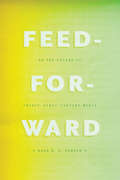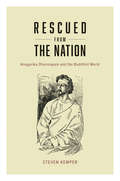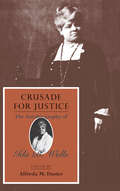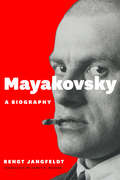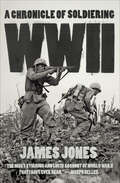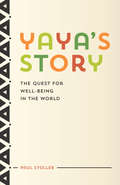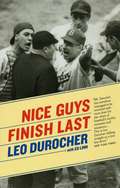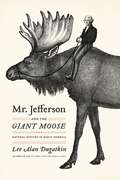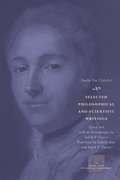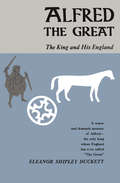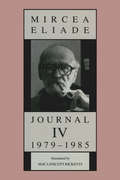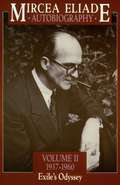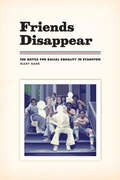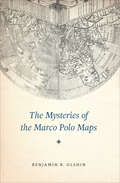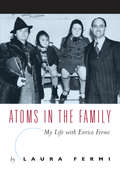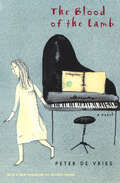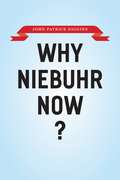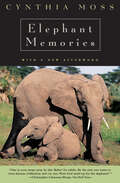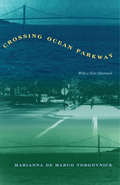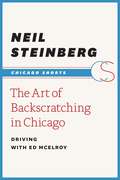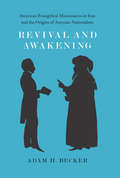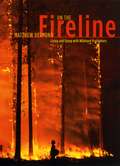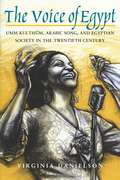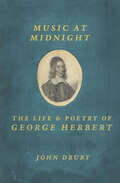- Table View
- List View
Feed-Forward: On the Future of Twenty-First-Century Media
by Mark B. N. HansenEven as media in myriad forms increasingly saturate our lives, we nonetheless tend to describe our relationship to it in terms from the twentieth century: we are consumers of media, choosing to engage with it. In Feed-Forward, Mark B. N. Hansen shows just how outmoded that way of thinking is: media is no longer separate from us but has become an inescapable part of our very experience of the world. Drawing on the speculative empiricism of philosopher Alfred North Whitehead, Hansen reveals how new media call into play elements of sensibility that greatly affect human selfhood without in any way belonging to the human. From social media to data-mining to new sensor technologies, media in the twenty-first century work largely outside the realm of perceptual consciousness, yet at the same time inflect our every sensation. Understanding that paradox, Hansen shows, offers us a chance to put forward a radically new vision of human becoming, one that enables us to reground the human in a non-anthropocentric view of the world and our experience in it.
Rescued from the Nation: Anagarika Dharmapala and the Buddhist World
by Steven KemperAnagarika Dharmapala is one of the most galvanizing figures in Sri Lanka’s recent turbulent history. He is widely regarded as the nationalist hero who saved the Sinhala people from cultural collapse and whose "protestant” reformation of Buddhism drove monks toward increased political involvement and ethnic confrontation. Yet as tied to Sri Lankan nationalism as Dharmapala is in popular memory, he spent the vast majority of his life abroad, engaging other concerns. In Rescued from the Nation, Steven Kemper reevaluates this important figure in the light of an unprecedented number of his writings, ones that paint a picture not of a nationalist zealot but of a spiritual seeker earnest in his pursuit of salvation. Drawing on huge stores of source materials--nearly one hundred diaries and notebooks--Kemper reconfigures Dharmapala as a world-renouncer first and a political activist second. Following Dharmapala on his travels between East Asia, South Asia, Europe, and the United States, he traces his lifelong project of creating a unified Buddhist world, recovering the place of the Buddha’s Enlightenment, and imitating the Buddha’s life course. The result is a needed corrective to Dharmapala’s embattled legacy, one that resituates Sri Lanka’s political awakening within the religious one that was Dharmapala’s life project.
Crusade for Justice: The Autobiography of Ida B. Wells (Negro American Biographies and Autobiographies)
by Ida B. Wells edited by Alfreda M. DusterIda B. Wells (1862-1931) was one of the foremost crusaders against black oppression. This engaging memoir tells of her private life as mother of a growing family as well as her public activities as teacher, lecturer, and journalist in her fight against attitudes and laws oppressing blacks. "No student of black history should overlook Crusade for Justice. "—William M. Tuttle, Jr. , Journal of American History "Besides being the story of an incredibly courageous and outspoken black woman in the face of innumerable odds, the book is a valuable contribution to the social history of the United States and to the literature of the women's movement as well. "—Elizabeth Kolmer, American Quarterly "[Wells was] a sophisticated fighter whose prose was as though as her intellect. "—Walter Goodman, New York Times "An illuminating narrative of a zealous, race-conscious, civic- and church-minded black woman reformer, whose life story is a significant chapter in the history of Negro-White relations. "—Thelma D. Perry, Negro History Bulletin
Mayakovsky
by Bengt Jangfeldt Harry D. WatsonFew poets have led lives as tempestuous as that of Vladimir Mayakovsky. Born in 1893 and dead by his own hand in 1930, Mayakovsky packed his thirty-six years with drama, politics, passion, and--most important--poetry. An enthusiastic supporter of the Russian Revolution and the emerging Soviet State, Mayakovsky was championed by Stalin after his death and enshrined as a quasi-official Soviet poet, a position that led to undeserved neglect among Western literary scholars even as his influence on other poets has remained powerful. With Mayakovsky, Bengt Jangfeldt offers the first comprehensive biography of Mayakovsky, revealing a troubled man who was more dreamer than revolutionary, more political romantic than hardened Communist. Jangfeldt sets Mayakovsky’s life and works against the dramatic turbulence of his times, from the aesthetic innovations of the pre-revolutionary avant-garde to the rigidity of Socialist Realism and the destruction of World War I to the violence--and hope--of the Russian Revolution, through the tightening grip of Stalinist terror and the growing disillusion with Russian communism that eventually led the poet to take his life. Through it all is threaded Mayakovsky’s celebrated love affair with Lili Brik and the moving relationship with Lili’s husband, Osip, along with a brilliant depiction of the larger circle of writers and artists around Mayakovsky, including Maxim Gorky, Viktor Shklovsky, Alexander Rodchenko, and Roman Jakobson. The result is a literary life viewed in the round, enabling us to understand the personal and historical furies that drove Mayakovsky and generated his still-startling poetry. Illustrated throughout with rare images of key characters and locations, Mayakovsky is a major step in the revitalization of a crucial figure of the twentieth-century avant-garde.
WWII: A Chronicle of Soldiering
by James JonesThis &“unique and fascinating&” WWII memoir by the acclaimed author of From Here to Eternity and The Thin Red Line &“stands out as one of the most vivid&” (The Wall Street Journal). In 1975, James Jones was chosen to write the text for an oversized coffee table book featuring visual art from World War II. The book was a best seller, praised for both its images and for Jones&’s text. In subsequent decades, when it became impossible to reproduce the book with its original artwork, it fell out of print and was forgotten. But now, this edition of WWII makes Jones&’s stunning text—his only extended nonfiction writing on the war—available once again. Moving chronologically and thematically through the complex history of World War II, Jones interweaves his own vivid memories of soldiering in the Pacific—from the look on a Japanese fighter pilot&’s face as he bombed Pearl Harbor, so close that Jones could see him smile and wave, to hitting the beach under fire in Guadalcanal—while always returning to resounding larger themes. While much of WWII is a tribute to the commitment of American soldiers, Jones also pulls no punches when recounting questionable strategic choices, wartime suffering, disorganization, the needless loss of life, and the brutal realization that a soldier is merely a cog in a heartless machine
Yaya's Story: The Quest for Well-Being in the World
by Paul StollerYaya’s Story is a book about Yaya Harouna, a Songhay trader originally from Niger who found a path to America. It is also a book about Paul Stoller--its author--an American anthropologist who found his own path to Africa. Separated by ethnicity, language, profession, and culture, these two men’s lives couldn’t be more different. But when they were both threatened by a grave illness--cancer--those differences evaporated, and the two were brought to profound existential convergence, a deep camaraderie in the face of the most harrowing of circumstances. Yaya’s Story is that story. Harouna and Stoller would meet in Harlem, at a bustling African market where Harouna built a life as an African art trader and Stoller was conducting research. Moving from Belayara in Niger to Silver Spring, Maryland, and from the Peace Corps to fieldwork to New York, Stoller recounts their separate lives and how the threat posed by cancer brought them a new, profound, and shared sense of meaning. Combining memoir, ethnography, and philosophy through a series of interconnected narratives, he tells a story of remarkable friendship and the quest for well-being. It’s a story of difference and unity, of illness and health, a lyrical reflection on human resiliency and the shoulders we lean on.
Nice Guys Finish Last
by Leo Durocher Ed Linn“I believe in rules. Sure I do. If there weren't any rules, how could you break them?” The history of baseball is rife with colorful characters. But for sheer cantankerousness, fighting moxie, and will to win, very few have come close to Leo “the Lip” Durocher. Following a five-decade career as a player and manager for baseball’s most storied franchises, Durocher teamed up with veteran sportswriter Ed Linn to tell the story of his life in the game. The resulting book, Nice Guys Finish Last, is baseball at its best, brimming with personality and full of all the fights and feuds, triumphs and tricks that made Durocher such a success—and an outsized celebrity. Durocher began his career inauspiciously, riding the bench for the powerhouse 1928 Yankees and hitting so poorly that Babe Ruth nicknamed him “the All-American Out.” But soon Durocher hit his stride: traded to St. Louis, he found his headlong play and never-say-die attitude a perfect fit with the rambunctious “Gashouse Gang” Cardinals. In 1939, he was named player-manager of the Brooklyn Dodgers—and almost instantly transformed the underachieving Bums into perennial contenders. He went on to manage the New York Giants, sharing the glory of one of the most famous moments in baseball history, Bobby Thomson’s “shot heard ’round the world,” which won the Giants the 1951 pennant. Durocher would later learn how it felt to be on the other side of such an unforgettable moment, as his 1969 Cubs, after holding first place for 105 days, blew a seemingly insurmountable 8-1/2-game lead to the Miracle Mets. All the while, Durocher made as much noise off the field as on it. His perpetual feuds with players, owners, and league officials—not to mention his public associations with gamblers, riffraff, and Hollywood stars like George Raft and Larraine Day—kept his name in the headlines and spread his fame far beyond the confines of the diamond. A no-holds-barred account of a singular figure, Nice Guys Finish Last brings the personalities and play-by-play of baseball’s greatest era to vivid life, earning a place on every baseball fan’s bookshelf.
Mr. Jefferson and the Giant Moose: Natural History in Early America
by Lee Alan DugatkinIn the years after the Revolutionary War, the fledgling republic of America was viewed by many Europeans as a degenerate backwater, populated by subspecies weak and feeble. Chief among these naysayers was the French Count and world-renowned naturalist Georges-Louis Leclerc de Buffon, who wrote that the flora and fauna of America (humans included) were inferior to European specimens. Thomas Jefferson--author of the Declaration of Independence, U. S. president, and ardent naturalist--spent years countering the French conception of American degeneracy. His Notes on Virginia systematically and scientifically dismantled Buffon's case through a series of tables and equally compelling writing on the nature of his home state. But the book did little to counter the arrogance of the French and hardly satisfied Jefferson's quest to demonstrate that his young nation was every bit the equal of a well-established Europe. Enter the giant moose. The American moose, which Jefferson claimed was so enormous a European reindeer could walk under it, became the cornerstone of his defense. Convinced that the sight of such a magnificent beast would cause Buffon to revise his claims, Jefferson had the remains of a seven-foot ungulate shipped first class from New Hampshire to Paris. Unfortunately, Buffon died before he could make any revisions to his Histoire Naturelle,but the legend of the moose makes for a fascinating tale about Jefferson's passion to prove that American nature deserved prestige. In Mr. Jefferson and the Giant Moose,Lee Alan Dugatkin vividly recreates the origin and evolution of the debates about natural history in America and, in so doing, returns the prize moose to its rightful place in American history.
Selected Philosophical And Scientific Writings (Jossey-bass Guides To Online Teaching And Learning)
by Judith P. Zinsser Isabelle Bour Emilie Du ChâteletThough most historians remember her as the mistress of Voltaire, Emilie Du Châtelet (1706–49) was an accomplished writer in her own right, who published multiple editions of her scientific writings during her lifetime, as well as a translation of Newton’s Principia Mathematica that is still the standard edition of that work in French. Had she been a man, her reputation as a member of the eighteenth-century French intellectual elite would have been assured. In the 1970s, feminist historians of science began the slow work of recovering Du Châtelet’s writings and her contributions to history and philosophy. For this edition, Judith P. Zinsser has selected key sections from Du Châtelet’s published and unpublished works, as well as related correspondence, part of her little-known critique of the Old and New Testaments, and a treatise on happiness that is a refreshingly uncensored piece of autobiography—making all of them available for the first time in English. The resulting volume will recover Châtelet’s place in the pantheon of French letters and culture.
Alfred the Great: The King and His England
by Eleanor Shipley DuckettFilled with drama and action, here is the story of the ninth-century life and times of Alfred--warrior, conqueror, lawmaker, scholar, and the only king whom England has ever called "The Great." Based on up-to-date information on ninth-century history, geography, philosophy, literature, and social life, it vividly presents exciting views of Alfred in every stage of his long career and leaves the reader with a sharply-etched picture of the world of the Middle Ages.
Journal IV: 1979–1985
by Mircea EliadeJournal IV is the first publication, in a translation from the Romanian manuscript, of the journal that Mircea Eliade kept during the last seven years of his life. In this period, Eliade is ensconced as a famous scholar—his works are being translated into many languages and books about him arrive regularly in the mail. His encounters with scholars of like repute are recorded in the journal; after a party in Paris, Eliade shares a taxi with Claude Lévi-Strauss and inadvertently makes off with his raincoat. Running like a fault line through the peak of his success, however, is Eliade's painful awareness of his physical decline—failing vision, arthritic hands, and continual fatigue. Again and again he repeats how little time he has to finish the projects he is working on—his autobiography, the third and fourth volumes of his History of Religious Ideas, and the duties associated with his editorship of the Encyclopedia of Religion. He poignantly recounts the sharpest blow: the disorganization and eventual destruction by fire of his personal library. Within the scope of Journal IV Eliade and his world go to ruin. What does not decline is the vivid and persistent voice of Eliade the writer, an unbreaking voice that—with death only months away—plans a reply to critics, plots out an article, and ruminates on characters to people another novella.
Mircea Eliade: Exile's Odyssey, 1937–1960
by Mircea Eliade"Here finally are Eliade's memoirs of the first thirty years of his life in Mac Linscott Rickett's crisp and lucid English translation. They present a fascinating account of the early development of a Renaissance talent, expressed in everything from daily and periodical journalism, realistic and fantastic fiction, and general nonfiction works to distinguished contributions to the history of religions. Autobiography follows an apparently amazingly candid report of this remarkable man's progression from a mischievous street urchin and literary prodigy, through his various love affairs, a decisive and traumatic Indian sojourn, and active, brilliant participation in pre-World War II Romanian cultural life."—Seymour Cain, Religious Studies Review
Friends Disappear: The Battle for Racial Equality in Evanston
by Mary BarrA sociologist returns to her suburban Illinois hometown to compare the paths of black and white childhood friends in a “fascinating” mix of study and memoir (Chicago Tribune).Mary Barr thinks a lot about the old photograph on her refrigerator door. In it, she and a dozen or so friends from the Chicago suburb of Evanston sit on a porch. It’s 1974, the summer after they graduated from Nichols Middle School, and what strikes her immediately—aside from the Soul Train–era clothes—is the diversity of the group: boys and girls, black and white, in the variety of poses you’d expect from a bunch of friends on the verge of high school. But the photo also speaks to the history of Evanston, to integration, and to the ways that those in the picture experienced and remembered growing up in a place that many at that time considered to be a racial utopia.In Friends Disappear, Barr goes back to her old neighborhood and pieces together a history of Evanston with a particular emphasis on its neighborhoods, its schools, and its work life. She finds that there is a detrimental myth of integration surrounding Evanston despite bountiful evidence of actual segregation, both in the archives and from the life stories of her subjects. Curiously, the city’s own desegregation plan is partly to blame. The initiative called for the redistribution of students from an all-black elementary school to institutions situated in white neighborhoods. That, however, required busing, and between the tensions it generated and obvious markers of class difference, the racial divide, far from being closed, was widened. Friends Disappear highlights how racial divides limited the life chances of blacks while providing opportunities for whites, and offers an insider’s perspective on the social practices that doled out benefits and penalties based on race—despite attempts to integrate.“Barr’s gripping exploration of the divergent paths friends took away from a childhood snapshot combines the rigor of scholarship with the personal touch of memoir. I have rarely read a book that so effectively illustrates the persistence of racial disparities in the United States with unforgettable, wrenching life stories.” —Amanda Seligman, University of Wisconsin-MilwaukeeHonorable Mention, Midwest Sociological Society Distinguished Book Award
The Mysteries of the Marco Polo Maps
by Benjamin B. OlshinWhat&’s the truth behind the travels of Marco Polo? &“A fascinating tale about maps, history and exploration.&”—Times Literary Supplement (UK) In the thirteenth century, Italian merchant and explorer Marco Polo traveled from Venice to the far reaches of Asia, a journey he chronicled in a narrative titled Il Milione, later known as The Travels of Marco Polo. While Polo&’s writings would go on to inspire the likes of Christopher Columbus, scholars have long debated their veracity. Some have argued that Polo never even reached China—while others believe that he came as far as the Americas. Now, there&’s new evidence for this historical puzzle: a very curious collection of fourteen little-known maps and related documents said to have belonged to the family of Marco Polo himself. Here, historian of cartography Benjamin B. Olshin offers the first credible book-length analysis of these artifacts, charting their course from obscure origins in the private collection of Italian-American immigrant Marcian Rossi in the 1930s; to investigations of their authenticity by the Library of Congress, J. Edgar Hoover, and the FBI; to the work of the late cartographic scholar Leo Bagrow; to Olshin&’s own efforts to track down and study the Rossi maps, all but one of which are in the possession of Rossi&’s great-grandson. Are the maps forgeries, facsimiles, or modernized copies? Did Marco Polo&’s daughters—whose names appear on several of the artifacts—preserve in them geographic information about Asia first recorded by their father? Or did they inherit maps created by him? Did Marco Polo entrust the maps to an admiral with links to Rossi&’s family line? Or, if the maps have no connection to Marco Polo, who made them, when, and why? Regardless of the maps&’ provenance, this tale takes us on a fascinating journey, offering insights into Italian history, the age of exploration, and the wonders of cartography. &“Olshin&’s book tugs powerfully at the imagination of anybody interested in the Polo story, medieval history, old maps, geographical ideas, European voyages of discovery, and early Chinese legends.&”—The Wall Street Journal
Atoms in the Family: My Life with Enrico Fermi
by Laura FermiIn this absorbing account of life with the great atomic scientist Enrico Fermi, Laura Fermi tells the story of their emigration to the United States in the 1930s—part of the widespread movement of scientists from Europe to the New World that was so important to the development of the first atomic bomb. Combining intellectual biography and social history, Laura Fermi traces her husband's career from his childhood, when he taught himself physics, through his rise in the Italian university system concurrent with the rise of fascism, to his receipt of the Nobel Prize, which offered a perfect opportunity to flee the country without arousing official suspicion, and his odyssey to the United States.
Mircea Eliade: Journey East, Journey West, 1907–1937
by Mircea Eliade"Here finally are Eliade's memoirs of the first thirty years of his life in Mac Linscott Rickett's crisp and lucid English translation. They present a fascinating account of the early development of a Renaissance talent, expressed in everything from daily and periodical journalism, realistic and fantastic fiction, and general nonfiction works to distinguished contributions to the history of religions. Autobiography follows an apparently amazingly candid report of this remarkable man's progression from a mischievous street urchin and literary prodigy, through his various love affairs, a decisive and traumatic Indian sojourn, and active, brilliant participation in pre-World War II Romanian cultural life."—Seymour Cain, Religious Studies Review
The Blood of the Lamb: A Novel
by Peter De VriesThis autobiographical novel of family tragedy by the author of Slouching Towards Kalamazoo &“moves deftly from manic hilarity to manic fury, and back again&” (Newsday). The most poignant of Peter De Vries&’s novels, The Blood of the Lamb is also his most personal. It follows the life of Don Wanderhop from his childhood in an immigrant Calvinist family living in Chicago in the 1950s through the loss of a brother, his faith, his wife, and finally his daughter—a tragedy drawn directly from De Vries&’s own life. Despite its basis in personal tragedy, The Blood of the Lamb offers glimpses of the comic sensibility for which De Vries was famous. Written with a powerful blend of grief, love, wit, and fury, De Vries&’s &“sensitive treatment of the death of a beloved child it has scarcely a superior in contemporary fiction" (Chicago Tribune).
Why Niebuhr Now?
by John Patrick DigginsBarack Obama has called him "one of my favorite philosophers. " John McCain wrote that he is "a paragon of clarity about the costs of a good war. " Andrew Sullivan has said, "We need Niebuhr now more than ever. " For a theologian who died in 1971, Reinhold Niebuhr is maintaining a remarkably high profile in the twenty-first century. In Why Niebuhr Now? acclaimed historian John Patrick Diggins tackles the complicated question of why, at a time of great uncertainty about America's proper role in the world, leading politicians and thinkers are turning to Niebuhr for answers. Diggins begins by clearly and carefully working through Niebuhr's theology, which focuses less on God's presence than his absence--and the ways that absence abets the all-too-human sin of pride. He then shows how that theology informed Niebuhr's worldview, leading him to be at the same time a strong opponent of fascism and communism and a leading advocate for humility and caution in foreign policy. Turning to the present, Diggins highlights what he argues is a misuse of Niebuhr's legacy on both the right and the left: while neoconservatives distort Niebuhr's arguments to support their call for an endless war on terror in the name of stopping evil, many liberal interventionists conveniently ignore Niebuhr's fundamental doubts about power. Ultimately, Niebuhr's greatest lesson is that, while it is our duty to struggle for good, we must at the same time be wary of hubris, remembering the limits of our understanding. The final work from a distinguished writer who spent his entire career reflecting on America's history and promise, Why Niebuhr Now? is a compact and perceptive book that will be the starting point for all future discussions of Niebuhr.
Elephant Memories: Thirteen Years in the Life of an Elephant Family
by Cynthia Moss&“A style so conversational…that I felt like a privileged visitor riding beside her in her rickety Land-Rover as she showed me around the park." —The New York Times Book Review Cynthia Moss spent many years living in Kenya&’s Amboseli National Park and studying the elephants there, and her long-term research has revealed much of what we now know about these complex and intelligent animals. In this book, she shares a more up-close and personal perspective, chronicling the lives of the elephant families led by matriarchs Teresia, Slit Ear, Torn Ear, Tania, and Tuskless, including a rare look at calves and their development. This edition is also updated with a new afterword, catching up on the families, covering current conservation issues, and &“celebrating a species from which we could learn some moral as well as zoological lessons&” (Chicago Tribune). &“One is soon swept away by this &‘Babar&’ for adults. By the end, one even begins to feel an aversion for people. One wants to curse human civilization and cry out, &‘Now God stand up for the elephants!&’&”—The New York Times &“Moss speaks to the general reader, with charm as well as scientific authority…[An] elegantly written and ingeniously structured account.&”—TheWall Street Journal &“Any reader interested in animals will be captivated.&”—Publishers Weekly
Crossing Ocean Parkway
by Marianna De Marco TorgovnickGrowing up an Italian-American in the Bensonhurst neighborhood of New York city, Marianna De Marco longed for college, culture, and upward mobility. Her daydreams circled around WASP (White Anglo Saxon Protestant) heroes on television—like Robin Hood and the Cartwright family—but in Brooklyn she never encountered any. So she associated moving up with Ocean Parkway, a street that divides the working-class Italian neighborhood where she was born from the middle-class Jewish neighborhood into which she married. This book is Torgovnick's unflinching account of crossing cultural boundaries in American life, of what it means to be an Italian American woman who became a scholar and literary critic. Included are autobiographical moments interwoven with engrossing interpretations of American cultural icons from Dr. Dolittle to Lionel Trilling, The Godfather to Camille Paglia. Her experiences allow her to probe the cultural tensions in America caused by competing ideas of individuality and community, upward mobility and ethnic loyalty, acquisitiveness and spirituality.
The Art of Backscratching in Chicago: Driving with Ed McElroy
by Neil Steinberg"Ed McElroy, clear of eye, sound of mind, and eighty-three years of age . . . guides his black Cadillac down Halsted Street. " So begins longtime Chicago journalist Neil Steinberg's nuanced homage to Ed McElroy: an old-school, behind-the-scenes backscratcher who has driven the rich, powerful, and well-connected around the city, doing favors and calling them in, for decades. Helping a young Steinberg understand the city, McElroy and his take on how a Mayor's son gets to be Mayor and how a wily up-and-comer marries the daughter of a powerful alderman and later becomes governor would enthrall even the most seasoned Chicagoan. In this drive around town and through time, Steinberg ultimately serves up audacious and funny anecdotes about how it helps to stay connected, to know a guy, and to help people out when you can.
Revival and Awakening: American Evangelical Missionaries in Iran and the Origins of Assyrian Nationalism
by Adam H. BeckerMost Americans have little understanding of the relationship between religion and nationalism in the Middle East. They assume that the two are rooted fundamentally in regional history, not in the history of contact with the broader world. However, as Adam H. Becker shows in this book, Americans--through their missionaries--had a strong hand in the development of a national and modern religious identity among one of the Middle East's most intriguing (and little-known) groups: the modern Assyrians. Detailing the history of the Assyrian Christian minority and the powerful influence American missionaries had on them, he unveils the underlying connection between modern global contact and the retrieval of an ancient identity. American evangelicals arrived in Iran in the 1830s. Becker examines how these missionaries, working with the "Nestorian" Church of the East--an Aramaic-speaking Christian community in the borderlands between Qajar Iran and the Ottoman Empire--catalyzed, over the span of sixty years, a new national identity. Instructed at missionary schools in both Protestant piety and Western science, this indigenous group eventually used its newfound scriptural and archaeological knowledge to link itself to the history of the ancient Assyrians, which in time led to demands for national autonomy. Exploring the unintended results of this American attempt to reform the Orient, Becker paints a larger picture of religion, nationalism, and ethnic identity in the modern era.
On the Fireline: Living and Dying with Wildland Firefighters
by Matthew DesmondIn this rugged account of a rugged profession, Matthew Desmond explores the heart and soul of the wildland firefighter. Having joined a firecrew in Northern Arizona as a young man, Desmond relates his experiences with intimate knowledge and native ease, adroitly balancing emotion with analysis and action with insight. On the Fireline shows that these firefighters aren’t the adrenaline junkies or romantic heroes as they’re so often portrayed.
The Voice of Egypt
by Virginia DanielsonUmm Kulthum, the "voice of Egypt," was the most celebrated musical performer of the century in the Arab world. More than twenty years after her death, her devoted audience, drawn from all strata of Arab society, still numbers in the millions. Thanks to her skillful and pioneering use of mass media, her songs still permeate the international airwaves. In the first English-language biography of Umm Kulthum, Virginia Danielson chronicles the life of a major musical figure and the confluence of artistry, society, and creativity that characterized her remarkable career. Danielson examines the careful construction of Umm Kulthum's phenomenal popularity and success in a society that discouraged women from public performance. From childhood, her mentors honed her exceptional abilities to accord with Arab and Muslim practice, and as her stature grew, she remained attentive to her audience and the public reception of her work. Ultimately, she created from local precendents and traditions her own unique idiom and developed original song styles from both populist and neo-classical inspirations. These were enthusiastically received, heralded as crowning examples of a new, yet authentically Arab-Egyptian, culture. Danielson shows how Umm Kulthum's music and public personality helped form popular culture and contributed to the broader artistic, societal, and political forces that surrounded her. This richly descriptive account joins biography with social theory to explore the impact of the individual virtuoso on both music and society at large while telling the compelling story of one of the most famous musicians of all time. "She is born again every morning in the heart of 120 million beings. In the East a day without Umm Kulthum would have no color. "--Omar Sharif
Music at Midnight: The Life and Poetry of George Herbert
by John DruryThis &“powerfully absorbing&” biography of 17th century Welsh poet George Herbert brings essential personal and social context to his immortal poetry (Financial Times). Though he never published any of his English poems during his lifetime, George Herbert has been celebrated for centuries as one of the greatest religious poets in the language. In this richly perceptive biography, author and theologian John Drury integrates Herbert&’s poems fully into his life, enriching our understanding of both the poet&’s mind and his work. As Drury writes in his preface, Herbert lived &“a quiet life with a crisis in the middle of it.&” Beginning with his early academic success, Drury chronicles the life of a man who abandons the path to a career at court and chooses to devote himself to the restoration of a church in Huntingdonshire and lives out his life as a country parson. Because Herbert&’s work was only published posthumously, it has always been difficult to know when or in what context he wrote his poems. But Drury skillfully places readings of the poems into his narrative, allowing us to appreciate not only Herbert&’s frame of mind while writing, but also the society that produced it. He reveals the occasions of sorrow, happiness, regret, and hope that Herbert captured in his poetry and that led T. S. Eliot to write, &“What we can confidently believe is that every poem . . . is true to the poet&’s experience.&” &“It is hard to imagine a better book for anyone, general reader or seventeenth-century aficionado or teacher or student, newly embarking on Herbert.&”—The Guardian, UK
